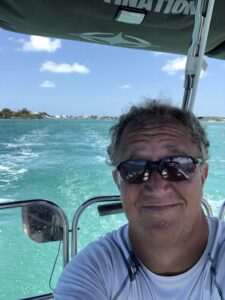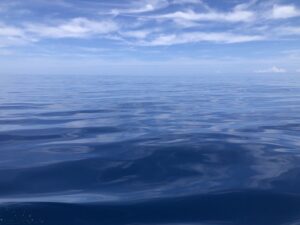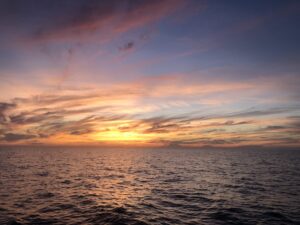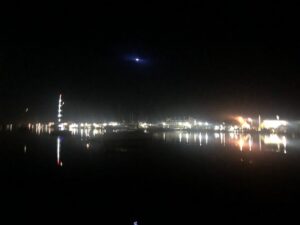Solo Passage
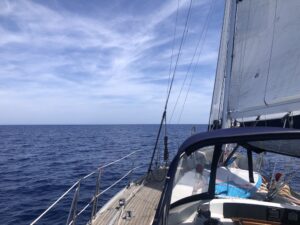
For 50 minutes on the final day, there was a wonderful breeze out of the west and northwest, making for some absolutely perfect sailing conditions
Yes, Further and I are once again in the United States. And to be honest: I’m not that happy about it (can’t speak for Further). We arrived in Beaufort, N.C., very late—1 a.m.—on Friday night/Saturday morning, and on Saturday when I went into town I was simply overwhelmed: the sheer cacophony of sounds, the volume of people, the frenetic activity everywhere…I was shell-shocked. (There was one pleasant aspect to the overwhelming nature of the scene here: I woke up to a profusion of bird song, something I’ve not heard since I left the U.S. months ago; I was stunned at how sparse the birds, and other wildlife, were in the Bahamas…very depressing.) It helped, i suppose, that it was a beautiful Saturday in Beaufort, a tourism-centric town normally and especially so here on the cusp of summer—indeed, there was a wooden boat show on the main street that day which was a nice surprise.
And the journey here was pretty uneventful—a good thing since it was my first true solo offshore passage. I left Marsh Harbour at 1 p.m. on Tuesday, 30 April, and anticipated the trip taking three-and-a-half days. The sailing was wonderful for the first eight or nine hours and that was a treat. By 9 or 10 p.m. that night, the wind had dropped and moved directly behind the boat—not a good combination but one that had been forecast. I turned on the engine and continued on into the night, but as the wind stayed down, I started getting nervous about the amount of diesel I carried on board. Further’s tank holds about 72 gallons and I also have a five-gallon jerry can on board. The engine burns about one gallon per hour, and it’s actually more like 1.1 or 1.2 gallons per hour. So that gave me about 72 hours of motoring (not counting the jerry can). The journey was supposed to take about 80 hours so given that I had sailed eight or nine hours, I should have been all right, right? But it was going to be close.
I got a little nervous when I ran into a noticeable adverse current that slowed my progress. I could see it on the water and it was amazing: there was a distinct line in the water where some small chop suddenly appeared on an otherwise calm sea surface. I proceeded and figured I’d work it out later. And I kinda did: that adverse current eventually faded and when I reached the Gulf Stream I gained a couple of knots of current in my favor for a good eight to ten hours. But still the wind never came up to offer enough help.
After exiting the Gulf Stream the going got really slow. Early Friday morning, getting nervous about the diesel supply, I turned off the engine and sailed along at a lethargic two knots or so. I wasn’t too worried about arrival times although there was some concern about stormy weather forecast for late Saturday; I just didn’t want to be wallowing around out there doing nothing.
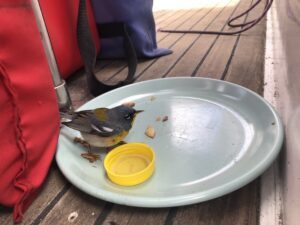
Petey the warbler (named for the dog in the Little Rascals) stopped by for a few-hour rest, a quick bite and then he was off again
At one point mid-morning on Friday there was a cloud line extending from horizon to horizon running from southwest to northeast. I thought there might be some wind under those clouds but was bitterly disappointed when they moved over me and the wind dropped even more. Sigh. BUT…a few minutes later, after the little front moved past, the wind went from south to west—a wonderful direction change for my northerly sail—in about five minutes and jumped up to nine and ten knots. Woohoo! The mainsail filled and I rolled out the jib and boom, and off we went. The wind hit eleven knots at times, but the big change was the direction: now being out the west and even northwest Further could really translate even that little bit of wind into good motion. We were doing more than six knots at times on just ten knots of wind…it was wonderful.
Unfortunately it only lasted about fifty minutes. But was that enough to put me in range of Beaufort with the diesel Further had on board? I didn’t really know. When the wind faded it dropped to even less than it had been before: it was now in the zero to one knot range so there was no real choice but to turn on the engine. This time, though, I poured the five gallons of diesel in the jug into the tank and ran the engine at very low power: about 1,150 RPMs rather than the 1,800 i had been running it at—which is still well below the 2,400-2,500 I run it when I want to roll. Would that be enough to reach Beaufort?
The funny thing is: if I’d had wind for another six or eight hours during the trip, or if my fuel tank held another twenty or so gallons of diesel, I could have run the trip at full throttle and reached Beaufort in about three days. As it was, i made it in exactly the forecast three-and-a-half days: I dropped the anchor at 1 a.m. on Saturday morning after departing on 1 p.m. on Tuesday. Turned out I did have enough diesel (just how much I used I’ll find out later today when I fuel up for my next move), although I really started sweating as we entered the channel at Beaufort Inlet around 11 p.m. and straight into the teeth of a fierce ebb tide running out to sea. Sigh. Never a dull moment.
When Further exited the main channel and made the turn into Taylor Creek on which the Beaufort waterfront is located I was exhausted but elated. I had made it: my first solo offshore passage and it hadn’t been a big deal other than the mental stress of the diesel question. I dropped the anchor among the other boats already there, had a beer and finally got to sleep around 2 a.m.
And speaking of sleep: that was my main concern before the trip but it turned out to be not a big deal. I eventually settled on a system where I’d set my timer for thirty minutes and lie down for sleep in Further’s cockpit while the autopilot steered the boat. When the alarm woke me I’d check the horizon, check the AIS system that tracks other boats and ships in the area (and has an alarm if they’re going to get too close to my location), check the navigation to make sure we were still on course, check the engine gauges and then reset the timer and go back down for another thirty minutes. It doesn’t sound much but because there was really no other traffic on the entire trip—I saw half a dozen big ships and only one, a cruise ship, prompted me to divert my course—I got so many half-hour snoozes in that I was able to stay relatively sharp. In fact, given the scarcity of traffic and the fact that a small sailboat really doesn’t move very quickly, I probably could have set the timer to an hour or even more but I was just too nervous to take that chance. But the fact is: I did get enough sleep on the trip, though once the trip was over I slept very deeply and later than I normally do. And then later on Saturday I definitely felt zonked so, yeah, it was doable but taxing.
Anyway, yes, I made it. And here in Beaufort is where I close the loop on this grand journey. I blew past this place in November and now I’ll retrace my steps back up the ICW north to the Chesapeake. With the longer days this time of year I’ll do the trip quicker starting with a short, two-hour-ish first hop today to anchor out near Ben, the great guy from Annapolis I met in the Bahamas who did the same passage from Marsh Harbour. On Tuesday I’ll get rolling on my own and I’m planning on being back on the Chesapeake around Hampton/Norfolk by Thursday afternoon, and then I’ll either do one 24-hour hop or (as I did coming south in late October) three day sails up the bay to Annapolis.
So that gets me “home” by the coming weekend. The journey is winding down.
